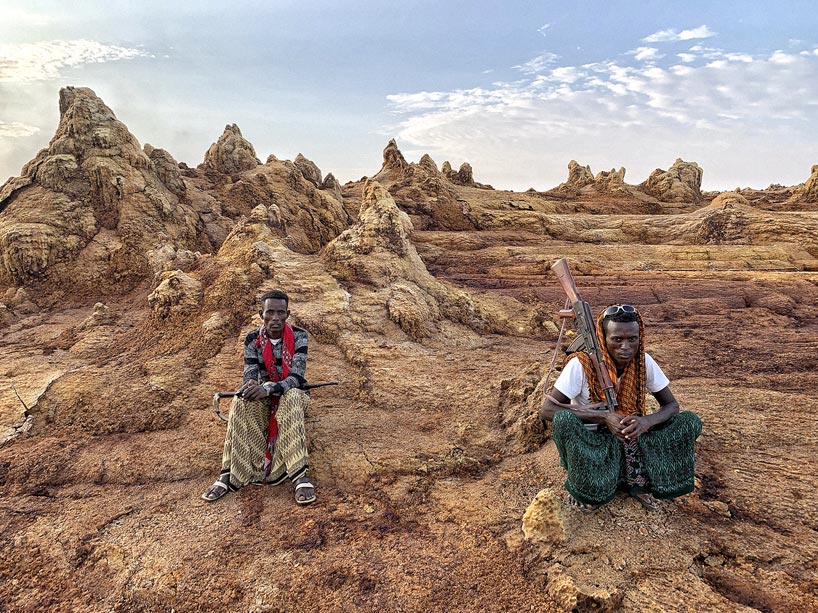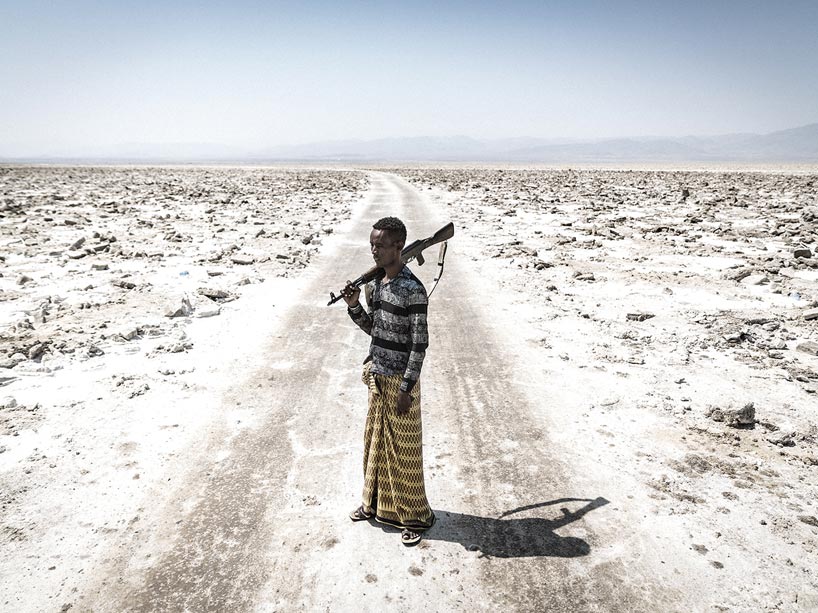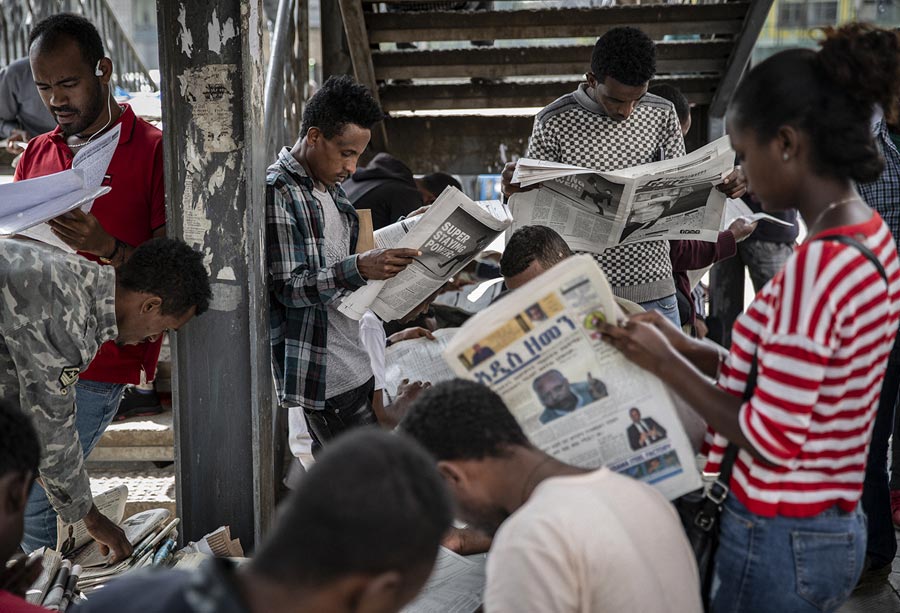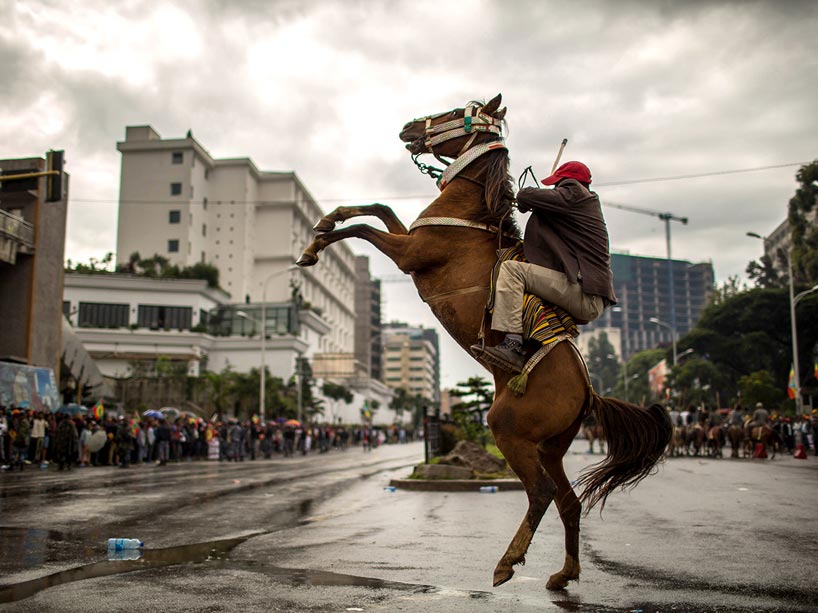Out of Africa

Afar militia men in the Danakil Depression, photographed for the Nobel Peace Prize exhibition. Photo: Finbarr O’Reilly.
Finbarr O’Reilly (Journalism ’97) is an esteemed photojournalist. So esteemed, in fact, that when he was named the Nobel Peace Prize photographer in 2019, some thought he’d won a prize that doesn’t actually exist.
“When the announcement was made there was a lot of misunderstanding that somehow there was a Nobel Peace Prize for photography – which there isn’t,” says O’Reilly. “So I was getting all these messages of congratulations.”
Congratulations were still in order, however, as the award-winning photographer was commissioned by the Nobel Peace Center to create an exhibition about the work of the 2019 Peace Prize winner, Ethiopia’s Prime Minister Abiy Ahmed Ali.

Afar militia man in the Danakil Depression, photographed for the Nobel Peace Prize exhibition. Photo: Finbarr O’Reilly.
For this project, he decided to take an innovative approach. “One of the most pressing things in our industry is the issue of representation and inclusivity,” O’Reilly explains. So he asked Aida Muluneh, the curator of the Addis Photo Festival, whether she’d be interested in collaborating with him. He felt it important to have “African voices included in shaping the narrative around their own country. So it wasn’t just an outsider’s view of what was happening.”
O’Reilly, Muluneh and seven Ethiopian photographers collaborated to mount the exhibition. Titled “Crossroads Ethiopia,” the collection reveals the impact Ahmed Ali has had – from his peace deal with neighbouring Eritrea, ending a 20-year border war, to his reforms granting amnesty to political prisoners, lifting a state of emergency, and appointing a cabinet in which half the ministers are women. The yearlong exhibition opened in December 2019 at the Nobel Peace Center in Oslo.

Newspapers for hire in Addis Ababa. Photo: Finbarr O’Reilly.
“It was the first time Black photographers had been shown as part of the Nobel Peace Prize exhibition, which was a historic moment in terms of photography,” says O’Reilly. “By entering into a collaboration like this, everybody wins – the exhibition becomes much deeper and much richer, and the Nobel Peace Center gains by having a body of work that’s much more representative and interesting, and of course the Ethiopian photographers also are included on a global platform that they might not otherwise have had.”
Collaboration and connection
Mulugeta Ayene is one of the Ethiopian photographers O’Reilly collaborated with for the Nobel exhibition. The image below by Ayene was part of the Ethiopian Spring series, which reflects the sense of liberation and hope of the country upon the election of the reformist Prime Minister Abiy Ahmed Ali.

In this photo, a man rides a horse on Saturday, Sept. 15, 2018, in Addis Ababa. The scene takes place as thousands gather to welcome returning leaders of the once-banned Oromo Liberation Front (OLF). The OLF was removed from a list of terror groups after Ahmed took office, amid sweeping reforms to bring opposition groups back to politics. Photo: Mulugeta Ayene (From Addis Foto Fest Archives, curated by Aida Muluneh for DFA).
From words to pictures
After completing Ryerson’s two-year graduate journalism program in 1997, O’Reilly spent his early career reporting for newspapers and magazines before heading to Congo in 2001 as a correspondent for Reuters. He began incorporating photography into his work when he was living in Rwanda with photographers who worked for competing wire services.
Through “good mentorship from photographers” and “a bit of luck and opportunity, things went quite well,” says O’Reilly. So well, in fact, that Reuters offered him a full-time photographer position in 2005. And in 2006, his photo of the malnourished fingers of a one-year-old pressed against his mother’s lips (external link) , taken during a famine in Niger, won the World Press Photo of the Year. Since then, he’s received first place awards from the National Press Photographers Association and Pictures of the Year International.
In recent years, O’Reilly has branched out into documentary filmmaking, acting as field producer for several projects, including a documentary on Ebola in Congo, and a film based in Madagascar about the criminal networks around the vanilla trade.
“As a field producer, I’m basically figuring out what the narrative is, who the characters are, how we want the story to flow, then all the logistics of getting what we need.”
Challenging perceptions
O’Reilly says his motivation as a photographer has evolved over the years. While most of his earlier work was in war zones – those experiences are documented in his memoir Shooting Ghosts – he’s now more interested in “everyday lives that people are living,” as he puts it.
Last year, for example, he won first prize in the World Press Photo Award’s singles portraits category, for his photo of a fashion shoot in Dakar, Senegal (external link) , where a Franco-African fashion scene is thriving.
“The way the mainstream media portrays stories from this part of the world has a certain sameness to it. I don’t necessarily want to photograph the extremes that I was often covering as a newswire journalist.” He says. “Now I look [to create] more nuanced work and work that, in a way, challenges people’s perceptions of a place.”
Current projects
O’Reilly continues to tackle complex issues in his work. He recently covered the fight against Islamic extremism in the Sahel region of Africa for The New York Times.
And in April, O’Reilly was awarded the 11th Carmignac Photojournalism Award, which, this year, focuses on the Democratic Republic of Congo (DRC).
Recognizing the circumstances of the COVID-19 pandemic, the prize now involves an online project by O’Reilly titled “Congo in Conversation (external link) ,” launched April 28. Its stream of articles, photojournalism and videos aims to address the human, social and ecological challenges that the Congo faces today with this new health crisis.
View this post on InstagramA post shared by Finbarr O'Reilly (@finbarroreilly) on
“Coronavirus means my travel is on hold until borders reopen,” O’Reilly posted on his Instagram (external link) account, “but we will be collaborating with Congolese journalists to share and highlight their important work during these unprecedented times.”
This story was first published in the summer edition of Ryerson University Magazine (external link) .